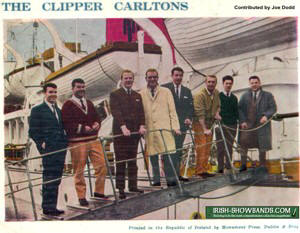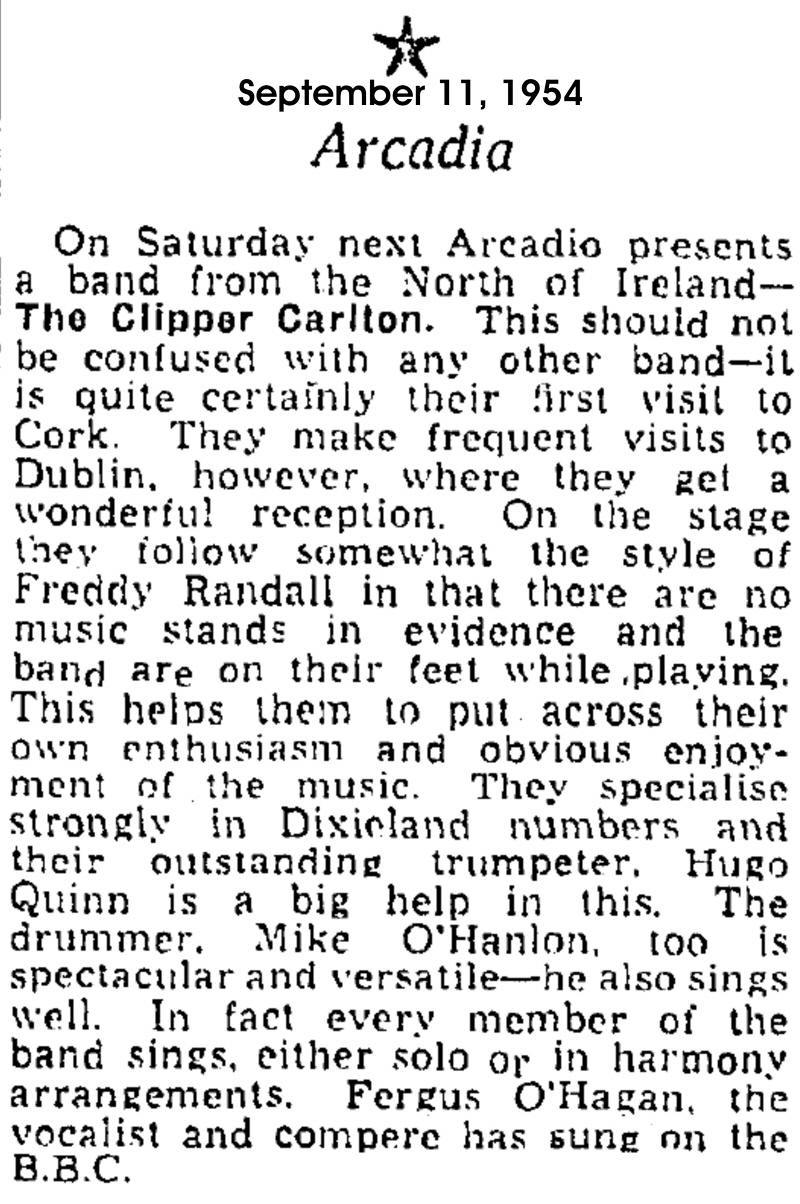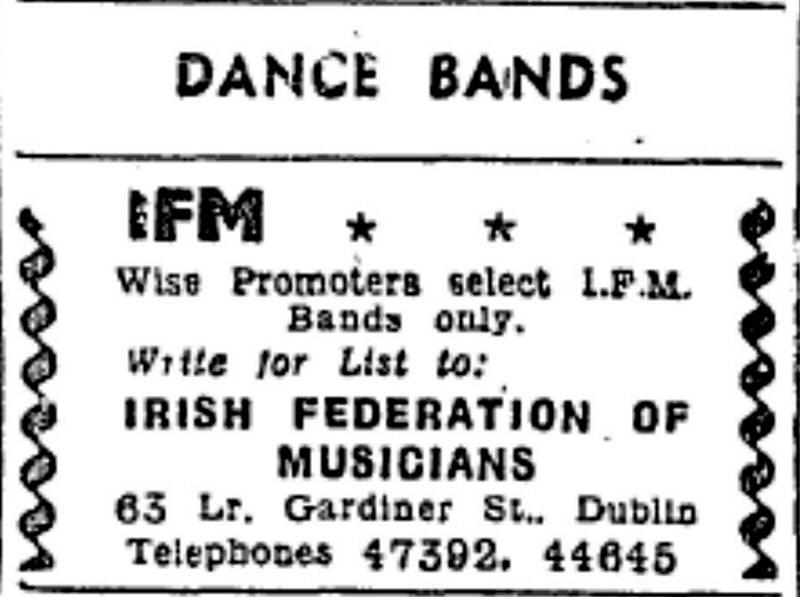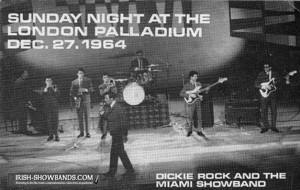1960's - The Showbands
 Legend
has it that the Clipper Carlton (known for years as Hugh Toorish and
his Clipper Carlton Dance Band or Orchestra) were the first to
dispense with their music stands and begin to move about on stage.
We have found an advert for the band in Cork in 1954 which said
there were "no music stands" on stage "in the style of Freddy
Randall." Freddy was an English jazz trumpeter who had toured
Ireland earlier that year. We have interviewed several musicians who
played in those days including Mickey Brennan from Sligo who started
his career in 1957 with the Clefonaires and he said they were very
influenced by bands like Freddy Randall and Chris Barber who also
stood while they played. It would appear that the move to stand
while performing was probably influenced more by English jazz bands
than any home grown Irish factors.
Legend
has it that the Clipper Carlton (known for years as Hugh Toorish and
his Clipper Carlton Dance Band or Orchestra) were the first to
dispense with their music stands and begin to move about on stage.
We have found an advert for the band in Cork in 1954 which said
there were "no music stands" on stage "in the style of Freddy
Randall." Freddy was an English jazz trumpeter who had toured
Ireland earlier that year. We have interviewed several musicians who
played in those days including Mickey Brennan from Sligo who started
his career in 1957 with the Clefonaires and he said they were very
influenced by bands like Freddy Randall and Chris Barber who also
stood while they played. It would appear that the move to stand
while performing was probably influenced more by English jazz bands
than any home grown Irish factors.

Interestingly, this move would change the entire industry in Ireland but
as is often the case in the entertainment
world, the innovators do not always reap the greatest benefit from
their own invention. Although the Clipper Carlton were very
successful, the band would not reach the popularity of many of the bands
that followed. Perhaps it is because they remained a "band," each
member contributing their share to the overall sound and
entertainment value of the band, but none grabbing the spotlight.
Another reason for the lack of hysteria on the part of dancers was
their age, by the time they kicked away their music stands, Hugh
Toorish had
been on the road since 1926 and even though they had new members in
the lineup in the mid 1950's by the early 1960's many of them were
seen as middle aged
men by younger dancers.
The unequaled form of mass fan hysteria would be
reserved for the bands that copied and followed the Clippers, but
with one exception...almost all these other bands would eventually
feature a distinct front person (mostly males, but some women
also grabbed their share of the limelight in the sixties.) Although
most showbands went by a single name, the most famous bands
eventually had a
featured lead singer. Names like Brendan Bowyer, Dickie Rock, Eileen
Reid, Butch
Moore, and others dominated the stage, and further defined the era
of the showbands.
One of the rarely mentioned aspects of the
early days of the showbands was the importance of the Irish
Federation of Musicians (IFM). Headquartered in Dublin with branch offices
in Athlone, Limerick and Cork, membership in the federation was a
necessity if one wanted to play in the Irish ballrooms. Over time
this power diminished and by the early 1970's membership in the
federation was rarely mentioned, although still (I think) desired
by some musicians. In a May, 1967 issue of Spotlight magazine, Gay Byrne
reported the figures from the Federation as reported by Jack Flahive.
By the way, membership included a music test in which potential
members were asked to sight read music.
 At the time, there were "136 bands in Dublin,
47 in Athlone branch, 43 in Limerick branch and 43 in Cork branch."
Said Jack, "Of these, approximately 24 are the legitimate reading
type of band and 249 are showbands." A somewhat derogatory view of
the vast majority of Irish entertainers at the the time. With
another 180 bands registered in the North, there were approximately
450 "official" bands touring Ireland in 1967, but there
actually many more.
At the time, there were "136 bands in Dublin,
47 in Athlone branch, 43 in Limerick branch and 43 in Cork branch."
Said Jack, "Of these, approximately 24 are the legitimate reading
type of band and 249 are showbands." A somewhat derogatory view of
the vast majority of Irish entertainers at the the time. With
another 180 bands registered in the North, there were approximately
450 "official" bands touring Ireland in 1967, but there
actually many more.
Where did all these musicians come from you may
ask. Well, almost all started as part timers, playing music while
labouring away at their "day jobs." Joe Dolan started life as a
qualified compositor (printing), brother Ben was a carpenter. Tony
Kenny was a butcher and Sonny Knowles was a tailor. Butch Moore was
a printer as well and continued to pay his union dues (just in case
the music didn't work out). Dickie Rock was serving his time to be
an electrical welder and Dermot O'Brien was a public servant working
for the Meath Country Council for over 10 years before deciding to
turn "pro." Ordinary lads pursuing (at the time) an extraordinary
career path.
But back to the history....
The main differences between the orchestras and
the showbands were a reduced number of players (usually 7 or 8); the
addition of electric guitars and bass; and often the trading in of the
trusty piano for an electric organ. The showbands retained a full complement of
brass, (usually one of each instrument) a sound that would define
their music for the next decade.
 The undisputed kings of this era were
The Royal
Showband from Waterford. They were formed in 1957 as
a part time band featuring local paper mill clerks Tom Dunphy and
Brendan Bowyer. Offstage, Brendan was shy and
retiring, and played trombone with the band. However, onstage he
became a different person and it wasn't long before his gyrating
hips and wild take off on Elvis gained him national fame. It was
1958 and Ireland had its first superstar. Between Tom's country
crooning and Brendan's wild rock n' roll act, the band was a huge
success all across the country, far outpacing the popularity of the
band on which they had originally patterned themselves,
the Clippers.
The undisputed kings of this era were
The Royal
Showband from Waterford. They were formed in 1957 as
a part time band featuring local paper mill clerks Tom Dunphy and
Brendan Bowyer. Offstage, Brendan was shy and
retiring, and played trombone with the band. However, onstage he
became a different person and it wasn't long before his gyrating
hips and wild take off on Elvis gained him national fame. It was
1958 and Ireland had its first superstar. Between Tom's country
crooning and Brendan's wild rock n' roll act, the band was a huge
success all across the country, far outpacing the popularity of the
band on which they had originally patterned themselves,
the Clippers.
The incredible rise of the showbands as the
sixties started created an entire industry that employed upwards of
10,000 people at its height.
Ballrooms started to spring up all
around the country as the old parochial halls could no longer cope
with the huge crowds the bands were attracting. Most of these
facilities were thrown up in a matter of months, with little in the
way of creature comforts. They had one purpose and one alone,
accommodate
as many dancers as possible.
 Things
started to roll along as in 1962 the Royal released the first single
by a showband, Come Down The
Mountain, Katy Daly, featuring Tom Dunphy. The song was a danceable
country/Irish folk and an instant hit.
However, nothing
was to prepare the industry for the magic that was 1963. That year,
Brendan recorded "Kiss Me Quick," which was to become the first
number one single in the Irish charts by a showband. They also starred in the film, "The
One Nighters," which was produced by Peter Collinson and followed
the band through their "wholesome" private lives and onto the stage.
Things
started to roll along as in 1962 the Royal released the first single
by a showband, Come Down The
Mountain, Katy Daly, featuring Tom Dunphy. The song was a danceable
country/Irish folk and an instant hit.
However, nothing
was to prepare the industry for the magic that was 1963. That year,
Brendan recorded "Kiss Me Quick," which was to become the first
number one single in the Irish charts by a showband. They also starred in the film, "The
One Nighters," which was produced by Peter Collinson and followed
the band through their "wholesome" private lives and onto the stage.
The same year, a new magazine dedicated to covering
the exploding showband scene made it's debut...Spotlight was
published for the first time. The magazine was filled with photos of
the bands and their stars and featured stories which followed their
every move. If that wasn't enough, the fledgling Telefís
Ireland, Ireland's only television station, which had just
gone on the air on December 31, 1961 produced "The
Showband Show." The weekly hour long show was to Irish
showbands what The Ed Sullivan Show was in the States. An appearance
with host, Paul Russell, assured bands national exposure, which they
translated into higher fees with promoters.
 From 1963 through 1968 the showband era was at
it's height. Ireland had it's own entertainment royalty, led by
names like Brendan Bowyer and the Royal,
Brendan O'Brien and the Dixies,
Dickie Rock and the Miami,
Joe Dolan
and the Drifters, Butch Moore and the Capitol, and many more.
From 1963 through 1968 the showband era was at
it's height. Ireland had it's own entertainment royalty, led by
names like Brendan Bowyer and the Royal,
Brendan O'Brien and the Dixies,
Dickie Rock and the Miami,
Joe Dolan
and the Drifters, Butch Moore and the Capitol, and many more.
This period also saw the rise of the folk scene
in Ireland with artists like Johnny McEvoy and
Danny Doyle leading
the way. In fact, during the mid sixties, controversy raged on the
Irish entertainment scene as many showbands saw "folk" music as a
way to sell records. This lead to numerous accusations that
showbands were trying to "out folk" the folkies.
As the sixties came to a close, several changes
started to occur in the world of the showbands. The huge influx of "copy cat"
showbands led to a glut on the market. In fact, other than the
distinct voices of a hand full of stars, the showbands were
beginning to be accused of all
sounding and looking the same.
Another major change was the rise of Irish
ballads and folk. Early showband records had been copied from the
rock n' roll and pop stars like Elvis, Buddy Holly and others. But
by 1967, the folk revival had not only hit the Irish bars and
hotels, but also the ballrooms. Showbands started releasing (and
having major hits) with songs like Black Velvet Band,
Irish Soldier Boy, Streets of Baltimore, and many others.
Another major change was also happening. The
dancers that had been packing the halls in the late fifties and
early sixties were moving on, getting married, having kids and a
younger set of dancers were taking their place. In this environment,
bands like the Clippers and others started to look "old" and out of
date. From 1967 through 1970 the showband landscape underwent a lot
of changes.
Also during this time and especially between
1968 and into 1970, the local bar scene exploded with "lounge bars"
springing up all over the country. Although limited to opening times
set by the government's strict licensing laws (closing time was 10 pm on Sundays) the
lounge bars were catering to the aging dance crowd. With comfortable
surroundings, central heating, and drinks a-plenty the ballrooms
continued to lose crowds.
During this period the influence of the
Catholic Church also had a great impact on the showbands as it
forbid dancing during Lent (the forty days before Easter) as well as
on Saturdays and days before Holy Days in the Church's calendar. This
caused the bands to look for work elsewhere during Lent, which usually meant
going to England, Canada or the United States for extended tours. The
period lasted usually for the whole month of March (except for St.
Patrick's night) and into early April.
The late sixties (and in particular,
1967-1968) signaled the end of the "old" showband era and the
dawning of a new age. Several major bands split: The Miami broke up,
splitting into the Sands and the "New" Miami and the Drifters lost
all but two of its members to The Times. Bands that didn't split
brought in new blood to appeal to a younger audience, The
Pacific
replaced Sonny Knowles with Peter Lawlor, Butch Moore left the
Capitol and was replaced by John Drummond. And a slew of "new" bands
hit the scene: The Real McCoy, The
Mexicans,
Sands, Times, the list
went on and on.
The distinction between pop and country bands
became clearer as the bands could no longer be all things to all
people, and had to be "different" from their competition. Bands like the
Smokey Mountain Ramblers and
Cotton Mill Boys came on the scene, providing pure country and
bluegrass dance music, while showbands like
The Mainliners moved to
a distinctly country sound with Big Tom leading the way in the field
of "Country and Irish" along with Larry Cunningham of the
Mighty Avons
and Brian Coll of the Plattermen. Pop bands like the
Memories in the South and
Chips in the
North, started to attract a younger audience and the old showbands faced
difficult times.
Those that successfully redefined themselves
would continue to entertain new audiences. Those that couldn't went
by the wayside. As early as 1966, only ten years after the start of
the showband craze, critics were forecasting the end was in sight
for the showbands. Articles by prominent industry magazines foresaw
a bleak future for the bands and the ballrooms and many said it was
over.
Even though the huge crowds and fan mania of
the early to mid 60's was gone, the showband era was not done. After
a shakeout in the late sixties, the industry recreated itself in a
new way. Showbands morphed into pop or country acts; a smattering of
cabaret artists tried their hands in the ballrooms; the Beat groups
of Dublin became the pop and rock groups of the 70's and started to
challenge for their piece of the pie. The industry was transforming
itself......
Click here to continue
Click on one of the genres belo0w to learn more.

 Legend
has it that the Clipper Carlton (known for years as Hugh Toorish and
his Clipper Carlton Dance Band or Orchestra) were the first to
dispense with their music stands and begin to move about on stage.
We have found an advert for the band in Cork in 1954 which said
there were "no music stands" on stage "in the style of Freddy
Randall." Freddy was an English jazz trumpeter who had toured
Ireland earlier that year. We have interviewed several musicians who
played in those days including Mickey Brennan from Sligo who started
his career in 1957 with the Clefonaires and he said they were very
influenced by bands like Freddy Randall and Chris Barber who also
stood while they played. It would appear that the move to stand
while performing was probably influenced more by English jazz bands
than any home grown Irish factors.
Legend
has it that the Clipper Carlton (known for years as Hugh Toorish and
his Clipper Carlton Dance Band or Orchestra) were the first to
dispense with their music stands and begin to move about on stage.
We have found an advert for the band in Cork in 1954 which said
there were "no music stands" on stage "in the style of Freddy
Randall." Freddy was an English jazz trumpeter who had toured
Ireland earlier that year. We have interviewed several musicians who
played in those days including Mickey Brennan from Sligo who started
his career in 1957 with the Clefonaires and he said they were very
influenced by bands like Freddy Randall and Chris Barber who also
stood while they played. It would appear that the move to stand
while performing was probably influenced more by English jazz bands
than any home grown Irish factors.


 The undisputed kings of this era were
The undisputed kings of this era were
 Things
started to roll along as in 1962 the Royal released the first single
by a showband, Come Down The
Mountain, Katy Daly, featuring Tom Dunphy. The song was a danceable
country/Irish folk and an instant hit.
However, nothing
was to prepare the industry for the magic that was 1963. That year,
Brendan recorded "Kiss Me Quick," which was to become the first
number one single in the Irish charts by a showband. They also starred in the film, "The
One Nighters," which was produced by Peter Collinson and followed
the band through their "wholesome" private lives and onto the stage.
Things
started to roll along as in 1962 the Royal released the first single
by a showband, Come Down The
Mountain, Katy Daly, featuring Tom Dunphy. The song was a danceable
country/Irish folk and an instant hit.
However, nothing
was to prepare the industry for the magic that was 1963. That year,
Brendan recorded "Kiss Me Quick," which was to become the first
number one single in the Irish charts by a showband. They also starred in the film, "The
One Nighters," which was produced by Peter Collinson and followed
the band through their "wholesome" private lives and onto the stage.
 From 1963 through 1968 the showband era was at
it's height. Ireland had it's own entertainment royalty, led by
names like
From 1963 through 1968 the showband era was at
it's height. Ireland had it's own entertainment royalty, led by
names like